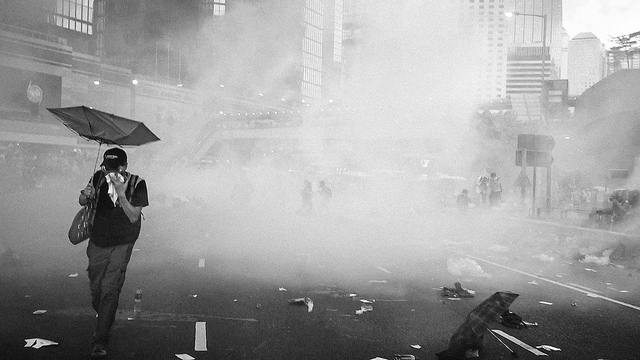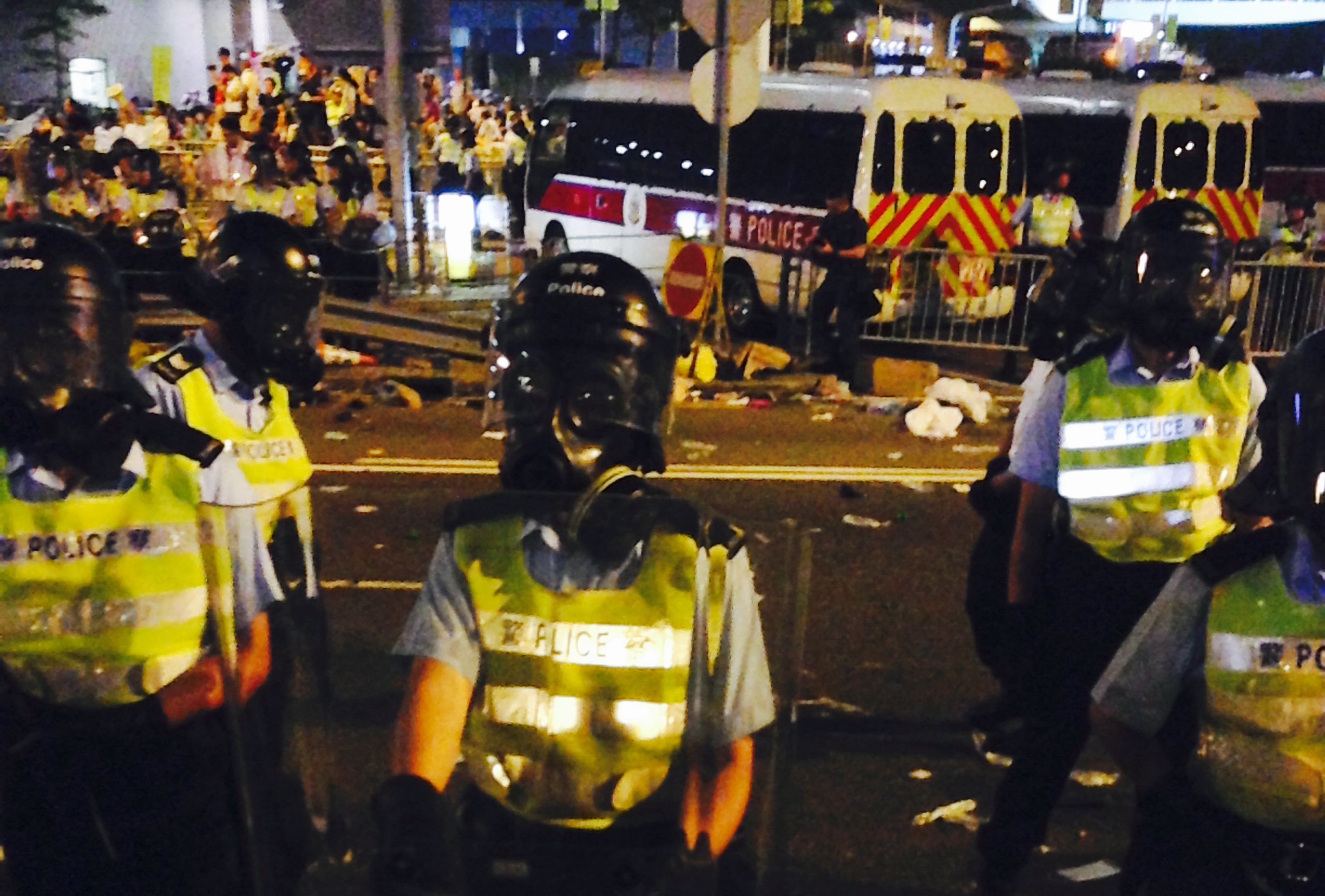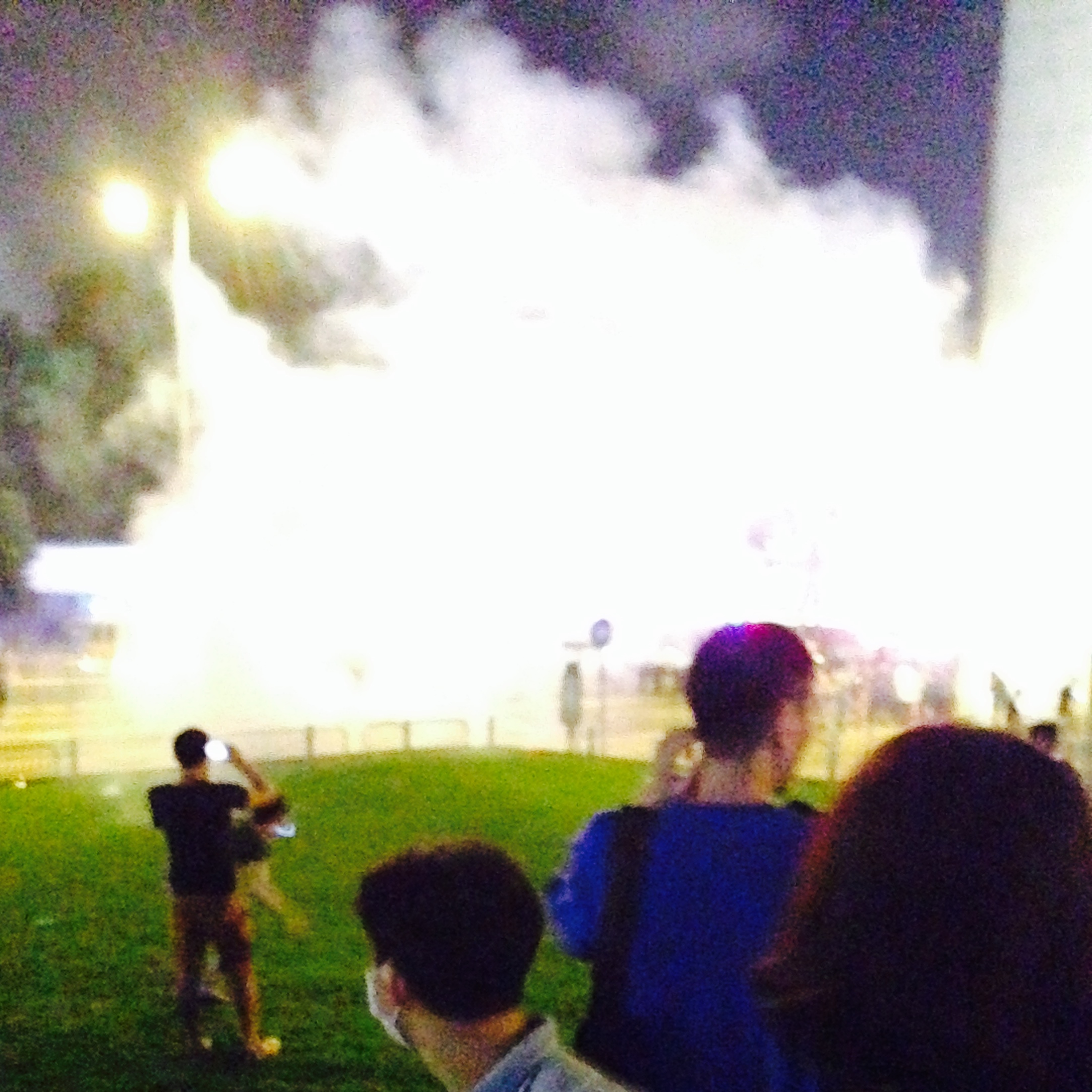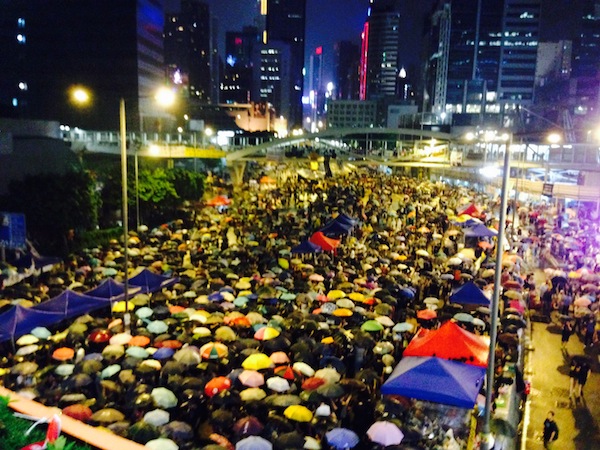
On Sunday, September 28, 2014, we stood among the estimated 80,000 Hong Kong protestors in the Admiralty neighborhood that hosts the government headquarters, when tear gas began raining down on us. The effects were immediate: a searing and near-paralyzing burn of our skin, eyes, nasal passages, and lungs that intensified with each attack, which totaled 87 rounds and an unknown number of canisters in nine different locations that night. Discomfort lasted for days afterward.
We are American expatriates who have lived in Hong Kong for years studying policy challenges facing transitional societies, but we don’t normally consider ourselves activists. We were out there because we have seen a disturbing erosion in the political freedoms and rights promised to our city since the 1997 handover to China, when it was agreed that Hong Kong would operate under “one country, two systems” for 50 years until 2047. Concern bubbled to the surface in 2003, when the Hong Kong government proposed security legislation that gave it the power to quash “subversion,” defined broadly to including legitimate dissidence and free speech. A 2012 effort to introduce national education reform promoting controversial “Chinese patriotism lessons” heightened concern. Both proposals were shelved after massive public protests, which were legal. Now, despite allowing everyone to vote for the chief executive in 2017, Beijing has established an ideological litmus test (candidates must “love the country”) and raised the requirements for becoming a candidate such that it effectively allows the Chinese Communist Party to choose the winner. In addition, fears were further raised by the language and timing of a June 2014 “white paper” that made it clear Hong Kong enjoys its autonomy entirely at the Chinese Communist Party’s discretion, sparking this movement that has gone beyond legal protests into occupying roads and other forms of civil disobedience.

Moreover, we were in the streets to acknowledge the growing discontent among Hong Kong residents over a widening economic disparity and the government’s role in creating it. In a city of millionaires and billionaires, where many well-off Mainland visitors happily spend their wealth, one-fifth of Hong Kong’s population currently lives below the poverty line (equivalent to $461 a month). Small business owners and entrepreneurs are finding it increasingly difficult to pay the escalating rent. The uneven distribution of wealth has only been exacerbated by Beijing’s strategy of allowing a few friendly tycoons’ businesses to grow exponentially, thereby consolidating power in a manageable number of “leaders” and stabilizing the political environment.
Our friends and family have been split about whether these protests are the right approach. Those who oppose the protests tend to view the relationship between China and Hong Kong as one of parent and child, do not see real threats to Hong Kong’s autonomy, and focus on the short-term view that Beijing will never give Hong Kong genuine universal suffrage when other parts of China don’t have it. But we reject the parent-child analogy of politics, and hold a longer view that is corroborated by history: Citizen protests, even ones that fail, are often necessary for societies to take incremental steps towards more equal and accountable states. We all share a baseline concern for the instability and economic distress brought about by protests, but we differ in choosing to weather the storm or to try to oppose the government directly.

We chose the more direct approach, which is how we ended up with the surreal experience of getting tear-gassed for the first time. Hong Kong protesters have long played by the rules–seeking advance approval for polite, organized marches. And the police have long enjoyed not only a sterling international reputation for their restraint when controlling crowds, but also a tight-knit and trusting relationship with the people. So we in Hong Kong have relegated tear gas in our collective consciousness to Hollywood or war zones, not thinking it would be possible in one of the safest and most orderly cities in the world.
Until it was. While we got away with minimal injuries, we saw plenty of people who were doubled over in pain on the street, crying as others washed out their eyes, or gasping for air. The protestors’ attempts to shield themselves with umbrellas have given rise to the nickname of this protest as the “Umbrella Movement.” Beyond its health effects, the tear gas helped us recognize the chasm that had been growing between the Hong Kong government and its people.
Beneath the shimmering skyscrapers, Hong Kong has prided itself on the rule of law and self-restraint when it comes to using the overwhelming force it possesses. This illusion was destroyed when the police crossed the line into violence: resorting to pepper spray, batons, and tear gas against peaceful protesters. It was further aggravated by an element of unchecked thuggery–organized bands, many with suspected triad connections, attacked protesters in the city’s Mong Kok area on October 3 and 4. The police largely stood by while this happened, in contrast to their earlier willingness to use force against peaceful protestors. Hong Kong residents realized that they had mistaken the orderliness and proceduralism of the Hong Kong government for benevolence.

The way in which the police carried out tear gas attacks on September 28 is even more worrisome. In both the Admiralty and Central districts, we saw police hurl gas canisters haphazardly, often into unsuspecting crowds, letting the toxins disperse in the air, attacking without regard to subject or intent. In an ensuing press conference, the police officially justified their decision in the name of public safety, saying they launched the tear gas to prevent stampedes and restore order. From what we have seen in our studies, however, gassing usually causes chaotic stampedes and injury. The only reason there were not massive injuries was the surprising levelheadedness of the protesters. With each attack, the protesters walked calmly away; the uninjured ones then returned under the instruction of organizers once the gas had dissipated. The police have reiterated their justifications. The public response was telling: Citizen participation in the protest surged after the tear gas and reports of thuggery.
Tear gas and other forms of violence are, of course, used by police to quell protests all over the world, and some commentators have been correct to point out that the police response would have been much more brutal elsewhere. However, these protests have typically been more peaceful and orderly than elsewhere; we witnessed protesters cleaning the streets in between rounds of tear gas, and when we saw some people throwing water bottles at the riot police, other protesters quickly admonished them. This rarity that has caught the attention of the international community, and the violence happened in a place where the police don’t typically react this way. So the situation felt like a betrayal. The time the decision was made to launch the first canister of tear gas was the moment the trust between state and citizen, and especially between the Hong Kong police and people, was lamentably lost. Whether that trust can be regained is entirely up to the government.
The actions of the administration during this protest do not bode well for the civility of future Hong Kong protests. And indeed, after a brief lull, the situation has escalated perhaps inevitably: In the early morning of October 15, police took action to clear protesters from a road with batons and pepper spray, but also attacked human rights observers wearing identification. And, a video has surfaced of police allegedly beating a handcuffed protestor whom they suspected of throwing water at them. The Hong Kong protesters have shown enormous self-discipline in adhering to the principle of non-violence thus far, but that may not last forever.
It’s highly likely that Umbrella Movement protestors took note of Taiwan’s Sunflower Movement from March to April of this year when students rose to combat a rushed trade agreement with China, fearing that economic dependence would eventually become a political crutch as well. There, too, students went from largely legal protests to occupying the legislature for several weeks. There, too, the police responded with violence (water cannons and batons). There, too, the students remained organized, peaceful, self-governing, and highly considerate. (For example, they designated smoking quotas so as to not discomfort non-smokers, and they cleaned the legislative building when they finally left.) To end the protests, the government promised to initiate a review of the trade agreement and to implement greater legislative transparency, which are still being negotiated. We can only hope–though we acknowledge it is sadly unlikely–that Hong Kong’s protests get resolved in a similar way.
Taiwan is, of course, a democratic system that is more accountable to the population, while the Hong Kong government is under no such constraint. Indeed, that is the existential issue behind the protests, and certainly not one that can be resolved with tear gas.




Send A Letter To the Editors